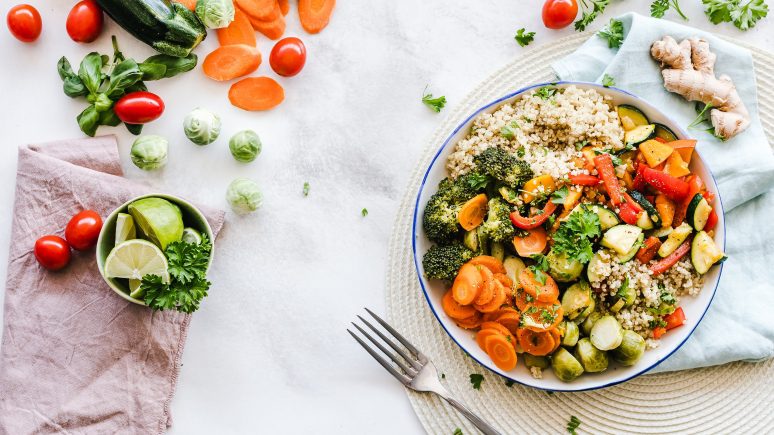Introduction
About 36% of the United States population has lactose intolerance. Such people cannot digest lactose – sugar present in milk. As a result, individuals with lactose intolerance experience unpleasant symptoms like bloating, stomach pain, and diarrhea after eating milk or dairy products.
The lactose-free diet, also called the dairy-free diet, is an eating pattern that excludes foods containing lactose. It is recommended for people with lactose intolerance, milk allergy, or other sensitivity to dairy products. In addition, some studies associate the consumption of dairy products with a higher risk of acne development.
Key points
The lactose-free diet excludes all products containing lactose. If you follow this nutritional approach, you should avoid all animal milk and dairy products, including cheese (especially soft cheese), yogurt, butter, buttermilk, sour cream, whipped cream, ice cream, dairy-based sherbet, and frozen yogurt.
In addition, remember to read food labels carefully. Some foods that may contain milk include:
- prepared foods like prepackaged meals
- bread, baked goods, tortillas, biscuits, and desserts
- dairy-based sauces, salad dressings, soups, and gravies
- instant mashed potatoes
- flavored potato chips
- processed meats like sausages, bacon, hot dogs, etc.
- some candies and breakfast cereals
- instant coffee
- cake, pancake, muffin, and waffle mixes
Various plant-based milk and dairy products substitutes exist that you can make a part of your lactose-free diet, including:
- lactose-free, nut, soy, hemp, flaxseed, and rice milk
- almond milk cheese, soy cheese
- nut, soy, and hemp milk yogurt
- vegetable oils blends, cultured vegan butter
- soy-based sour cream
- non-dairy milk ice cream, sorbets
It is worth mentioning that if you have a milk allergy, you should avoid the consumption of lactose-free milk and dairy because these products still contain milk protein.
Contraindications
There are no contraindications for a lactose-free diet.
How to avoid possible nutritional deficiencies
People following a lactose-free diet may experience deficiencies in essential nutrients like vitamin D, vitamin B-12 (riboflavin), calcium, zinc, and phosphorous. To ensure the adequate intake of these compounds, try to include some of the following foods in your diet:
- vitamin D: salmon, canned tuna, sardines, herring, cod liver oil, mushrooms, egg yolks, fortified foods;
- vitamin B-12 (riboflavin): clams, tuna, sardines, salmon, trout, eggs, animal kidneys and liver, beef, fortified foods;
- calcium: canned salmon, sardines, beans, lentils, seeds (chia seeds, poppy seeds, sesame seeds), almonds, leafy greens, rhubarb, almonds, fortified foods;
- zinc: red meat, legumes, nuts (almonds, cashews, peanuts, pine nuts), seeds (pumpkin seeds, hemp seeds, sesame seeds, squash seeds), eggs, whole grains, dark chocolate, shellfish;
- phosphorous: poultry, pork, seafood, organ meats, seeds (pumpkin seeds, sunflower seeds), nuts (brazil nuts, almonds, pine nuts, cashews, pistachios), soy, whole grains, beans, lentils;
Tips on improving your dieting experience
People following a dairy-free diet, especially those who do it because of lactose intolerance or allergy, should pay close attention to food labels. Thoroughly explore the list of ingredients which includes the information about all components, additives, and allergens present in the product.
Reading food labels, pay attention to ingredients like:
- lactose
- milk sugar
- milk powder
- milk casein
- dry milk solids
- lactose monohydrate
- whey
- cheese
- butter
- buttermilk
- curds
- cream
- sour cream
- milk
- evaporated milk
- condensed milk
- powdered milk
- malted milk
- whey
- whey protein concentrate
- milk byproducts
You should avoid these ingredients if you follow a lactose-free diet.
It is worth mentioning that, though having similar names, the following compounds do not contain lactose and can be a part of a dairy-free diet:
- lactic acid
- lactate
- lactitol
- lactic acid bacteria
- fermented lactic acid
- baking agents (or thickening agents/binding agents)
It is good to check food labels on products you regularly buy because manufacturers can change recipes from time to time. Therefore, food that didn’t contain lactose may now have it.
In some situations, the food doesn’t have a labeled package, for example, a meal in a restaurant. In this case, you can ask for information about the presence of lactose in the food. It can be provided in a written form (on the menu or a separate sheet), in electronic form (on the website), or verbally.
Conclusions
Overall, a lactose-free diet is a healthy option that benefits people with lactose intolerance or milk allergy. However, if you don’t have any of these conditions, there is no necessity to cut out lactose. Milk and dairy products are a part of a balanced diet. In addition, it may be complicated to ensure you are getting enough of all the nutrients. If you follow a dairy-free diet and are concerned that it is not well-balanced, contact a healthcare provider or a nutritionist to be advised on this topic.














Leave a Reply
You must be logged in to post a comment.